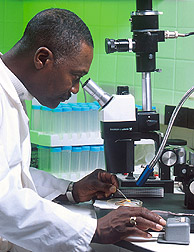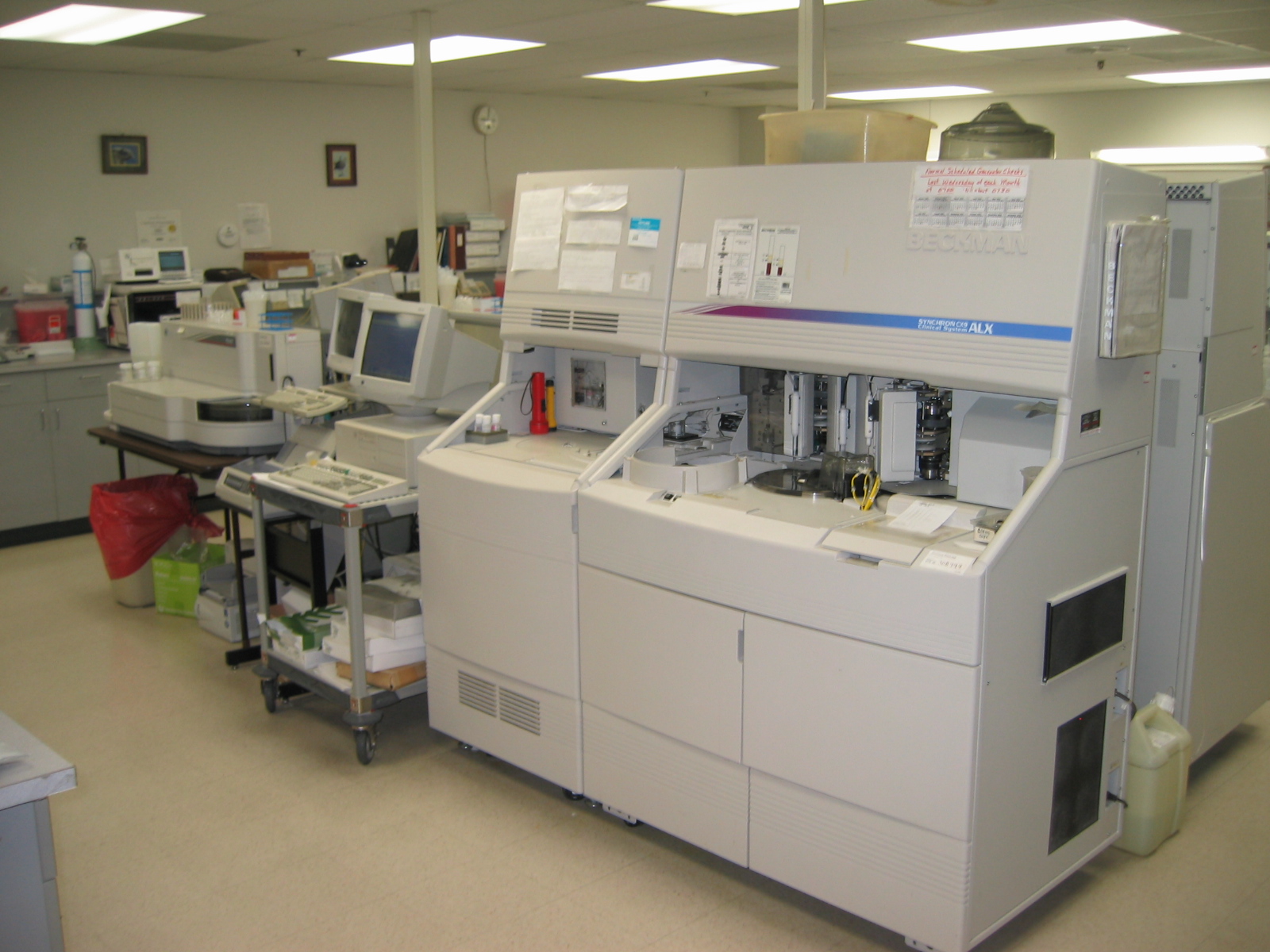|
Veterinary Pathology
Veterinary pathologists are veterinarians who specialize in the diagnosis of diseases through the examination of animal tissue and body fluids. Like medical pathology, veterinary pathology is divided into two branches, anatomical pathology and clinical pathology. Other than the diagnosis of disease in food-producing animals, companion animals, zoo animals and wildlife, veterinary pathologists also have an important role in drug discovery and safety as well as scientific research. Veterinary anatomical pathology Anatomical pathology (Commonwealth) or anatomic pathology (U.S.) is concerned with the diagnosis of disease based on the gross examination, microscopic, and molecular examination of organs, tissues, and whole bodies ( necropsy). Veterinary pathology also takes into account the structure and function of the body and how particular cells were injured. The Indian, European, Japanese, and American Colleges of Veterinary Pathologists certify veterinary pathologists t ... [...More Info...] [...Related Items...] OR: [Wikipedia] [Google] [Baidu] |
Mammary Tumor
A mammary tumor is a neoplasm originating in the mammary gland. It is a common finding in older female dogs and cats that are not spaying and neutering, spayed, but they are found in other animals as well. The mammary glands in dogs and cats are associated with their nipples and extend from the underside of the chest to the groin on both sides of the midline. There are many differences between mammary tumors in animals and breast cancer in humans, including tumor type, malignant, malignancy, and treatment options. The prevalence in dogs is about three times that of women. In dogs, mammary tumors are the second most common tumor (after skin tumors) over all and the most common tumor in female dogs with a reported incidence of 3.4%. Multiple studies have documented that spaying female dogs when young greatly decreases their risk of developing mammary neoplasia when aged. Compared with female dogs left intact, those spayed before puberty have 0.5% of the risk, those spayed after one es ... [...More Info...] [...Related Items...] OR: [Wikipedia] [Google] [Baidu] |
Necropsy
An autopsy (also referred to as post-mortem examination, obduction, necropsy, or autopsia cadaverum) is a surgical procedure that consists of a thorough examination of a corpse by dissection to determine the cause, mode, and manner of death; or the exam may be performed to evaluate any disease or injury that may be present for research or educational purposes. The term ''necropsy'' is generally used for non-human animals. Autopsies are usually performed by a specialized medical doctor called a pathologist. Only a small portion of deaths require an autopsy to be performed, under certain circumstances. In most cases, a medical examiner or coroner can determine the cause of death. Purposes of performance Autopsies are performed for either legal or medical purposes. Autopsies can be performed when any of the following information is desired: * Manner of death must be determined ** Determine if death was natural or unnatural ** Injury source and extent on the corpse * Post ... [...More Info...] [...Related Items...] OR: [Wikipedia] [Google] [Baidu] |
Molecular Pathology
Molecular pathology is an emerging discipline within pathology which is focused in the study and diagnosis of disease through the examination of molecules within organs, tissues or bodily fluids. Molecular pathology shares some aspects of practice with both anatomic pathology and clinical pathology, molecular biology, biochemistry, proteomics and genetics, and is sometimes considered a "crossover" discipline. It is multi-disciplinary in nature and focuses mainly on the sub-microscopic aspects of disease. A key consideration is that more accurate diagnosis is possible when the diagnosis is based on both the morphologic changes in tissues (traditional anatomic pathology) and on molecular testing. It is a scientific discipline that encompasses the development of molecular and genetic approaches to the diagnosis and classification of human diseases, the design and validation of predictive biomarkers for treatment response and disease progression, the susceptibility of individuals of d ... [...More Info...] [...Related Items...] OR: [Wikipedia] [Google] [Baidu] |
Hematology
Hematology (American and British English spelling differences#ae and oe, spelled haematology in British English) is the branch of medicine concerned with the study of the cause, prognosis, treatment, and prevention of diseases related to blood. It involves treating diseases that affect the production of blood and its components, such as blood cells, hemoglobin, blood proteins, bone marrow, platelets, blood vessels, spleen, and the mechanism of coagulation. Such diseases might include hemophilia, sickle cell anemia, blood clots (thrombus), other bleeding disorders, and blood cancers such as leukemia, multiple myeloma, and lymphoma. The laboratory analysis of blood is frequently performed by a medical technologist or medical laboratory scientist. Specialization Physicians specialized in hematology are known as hematologists or haematologists. Their routine work mainly includes the care and treatment of patients with hematological diseases, although some may also work at the hema ... [...More Info...] [...Related Items...] OR: [Wikipedia] [Google] [Baidu] |
Clinical Microbiology
Medical microbiology, the large subset of microbiology that is applied science, applied to medicine, is a branch of medical science concerned with the prevention, diagnosis and treatment of infection, infectious diseases. In addition, this field of science studies various clinical applications of microbes for the improvement of health. There are four kinds of microorganisms that cause infectious disease: bacteria, fungi, Parasitism, parasites and viruses, and one type of infectious protein called prion. A medical microbiologist studies the characteristics of pathogens, their modes of transmission, mechanisms of infection and growth. The academic qualification as a clinical/Medical Microbiologist in a hospital or medical research centre generally requires a Bachelors degree while in some countries a Masters in Microbiology along with Ph.D. in any of the life-sciences (Biochem, Micro, Biotech, Genetics, etc.). Medical microbiologists often serve as consultants for physicians, provid ... [...More Info...] [...Related Items...] OR: [Wikipedia] [Google] [Baidu] |
Urine
Urine is a liquid by-product of metabolism in humans and many other animals. In placental mammals, urine flows from the Kidney (vertebrates), kidneys through the ureters to the urinary bladder and exits the urethra through the penile meatus (males) or urethral meatus of the vulva (females) during urination. In other vertebrates, urine is excreted through the cloaca. Urine contains water-soluble by-products of Cell (biology), cellular metabolism that are rich in nitrogen and must be clearance (medicine), cleared from the Circulatory system, bloodstream, such as urea, uric acid and creatinine. A urinalysis can detect nitrogenous wastes of the mammalian body. Urine plays an important role in the earth's nitrogen cycle. In balanced ecosystems, urine fertilizes the soil and thus helps plants to grow. Therefore, Reuse of excreta, urine can be used as a fertilizer. Some animals use it to territory (animal)#Scent marking, mark their territories. Historically, aged or fermented urine (kn ... [...More Info...] [...Related Items...] OR: [Wikipedia] [Google] [Baidu] |
Blood
Blood is a body fluid in the circulatory system of humans and other vertebrates that delivers necessary substances such as nutrients and oxygen to the cells, and transports metabolic waste products away from those same cells. Blood is composed of blood cells suspended in blood plasma. Plasma, which constitutes 55% of blood fluid, is mostly water (92% by volume), and contains proteins, glucose, mineral ions, and hormones. The blood cells are mainly red blood cells (erythrocytes), white blood cells (leukocytes), and (in mammals) platelets (thrombocytes). The most abundant cells are red blood cells. These contain hemoglobin, which facilitates oxygen transport by reversibly binding to it, increasing its solubility. Jawed vertebrates have an adaptive immune system, based largely on white blood cells. White blood cells help to resist infections and parasites. Platelets are important in the clotting of blood. Blood is circulated around the body through blood vessels by the ... [...More Info...] [...Related Items...] OR: [Wikipedia] [Google] [Baidu] |
Bodily Fluid
Body fluids, bodily fluids, or biofluids, sometimes body liquids, are liquids within the body of an organism. In lean healthy adult men, the total body water is about 60% (60–67%) of the total body weight; it is usually slightly lower in women (52–55%). The exact percentage of fluid relative to body weight is inversely proportional to the percentage of body fat. A lean man, for example, has about 42 (42–47) liters of water in his body. The total body of water is divided into fluid compartments, between the intracellular fluid compartment (also called space, or volume) and the extracellular fluid (ECF) compartment (space, volume) in a two-to-one ratio: 28 (28–32) liters are inside cells and 14 (14–15) liters are outside cells. The ECF compartment is divided into the interstitial fluid volume – the fluid outside both the cells and the blood vessels – and the intravascular volume (also called the vascular volume and blood plasma volume) – the fluid inside t ... [...More Info...] [...Related Items...] OR: [Wikipedia] [Google] [Baidu] |
Medical Laboratory
A medical laboratory or clinical laboratory is a laboratory where tests are conducted out on clinical specimens to obtain information about the health of a patient to aid in diagnosis, treatment, and prevention of disease. Clinical medical laboratories are an example of applied science, as opposed to research laboratory, research laboratories that focus on basic science, such as found in some academia, academic institutions. Medical laboratories vary in size and complexity and so offer a variety of testing services. More comprehensive services can be found in acute-care hospitals and medical centers, where 70% of clinical decisions are based on laboratory testing. Doctors offices and clinics, as well as skilled nursing and Nursing home, long-term care facilities, may have laboratories that provide more basic testing services. Commercial medical laboratories operate as independent businesses and provide testing that is otherwise not provided in other settings due to low test vol ... [...More Info...] [...Related Items...] OR: [Wikipedia] [Google] [Baidu] |
Clinical Pathology
Clinical pathology is a medical specialty that is concerned with the diagnosis of disease based on the laboratory analysis of bodily fluids, such as blood, urine, and tissue homogenates or extracts using the tools of chemistry, microbiology, hematology, molecular pathology, and Immunohaematology. This specialty requires a medical residency. Clinical pathology is a term used in the US, UK, Ireland, many Commonwealth countries, Portugal, Brazil, Italy, Japan, and Peru; countries using the equivalent in the home language of "laboratory medicine" include Austria, Germany, Romania, Poland and other Eastern European countries; other terms are "clinical analysis" (Spain) and "clinical/medical biology (France, Belgium, Netherlands, North and West Africa). Licensing and subspecialities The American Board of Pathology certifies clinical pathologists, and recognizes the following secondary specialties of clinical pathology: * Chemical pathology, also called clinical chemistry * ... [...More Info...] [...Related Items...] OR: [Wikipedia] [Google] [Baidu] |
Tissue (biology)
In biology, tissue is an assembly of similar cells and their extracellular matrix from the same embryonic origin that together carry out a specific function. Tissues occupy a Biological organisation#Levels, biological organizational level between cell (biology), cells and a complete organ (biology), organ. Accordingly, organs are formed by the functional grouping together of multiple tissues. The English word "tissue" Morphological derivation, derives from the French word "", the past participle of the verb tisser, "to weave". The study of tissues is known as histology or, in connection with disease, as histopathology. Xavier Bichat is considered as the "Father of Histology". Plant histology is Studied Space Shuttle designs, studied in both plant anatomy and Plant physiology, physiology. The classical tools for studying tissues are the Microtome#Applications, paraffin block in which tissue is embedded and then sectioned, the staining, histological stain, and the Microscope, o ... [...More Info...] [...Related Items...] OR: [Wikipedia] [Google] [Baidu] |





